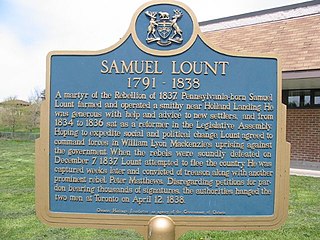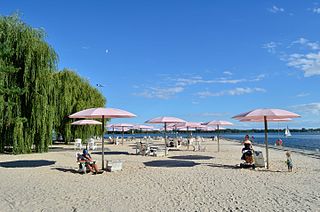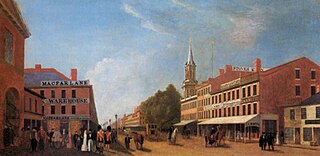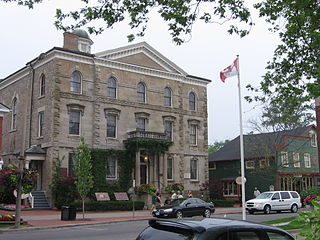
St. Lawrence is a neighbourhood located in downtown Toronto, Ontario, Canada. The area, a former industrial area, is bounded by Yonge, Front, and Parliament Streets, and the Canadian National railway embankment. The Esplanade off Yonge St., lined with restaurants, cafés and hotels runs through the middle of the area. In previous times, the area was sometimes referred to as 'St. Lawrence Ward' or more often today as 'St. Lawrence Market', synonymous with the large retail vendor market which is the neighbourhood's focal point. The area is the site of a large city-sponsored housing project of the 1970s, which revitalized an old brownfields area. The boundaries of the St Lawrence Neighbourhood Association and the St Lawrence Market BIA are somewhat larger than those noted above. Both groups have boundaries that extend from Yonge to Parliament Streets and Queen Street East to the rail corridor.

Front Street is an east–west road in downtown Toronto, Ontario, Canada. First laid out in 1796, the street is one of the original streets of the Town of York. The street was laid out along the shoreline of Lake Ontario as it existed during that time. It remains an important street, with many important uses located along it, including the St. Lawrence Market, Meridian Hall, Union Station and the Metro Toronto Convention Centre. The eastern section of Front Street, in the West Don Lands, east of Cherry Street, is being rebuilt as a broad tree-lined boulevard, intended to be the pedestrian-friendly commercial spine of the new neighbourhood.

The Parramatta Correctional Centre is a heritage-listed former medium security prison for males on the corner of O'Connell and Dunlop Streets, North Parramatta, Sydney, New South Wales, Australia. It was in operation between 1798 and 2011. The centre was initially called Parramatta Gaol until its name was changed to Parramatta Correctional Centre in 1992. When in operation, the centre was managed by Corrective Services NSW, an agency of the Department of Communities and Justice of the Government of New South Wales. Immediately prior to its closure, the centre detained short term sentenced and remand inmates, operated as a transient centre, and was the periodic detention centre for metropolitan Sydney.

Jarvis Collegiate Institute is a high school in Toronto, Ontario, Canada. It is named after Jarvis Street where it is located. It is a part of the Toronto District School Board (TDSB). Prior to 1998, it was within the Toronto Board of Education (TBE).

The Don Jail was a jail in Toronto, Ontario, Canada, located to the east of the Don River, on Gerrard Street East in the Riverdale neighbourhood. The original building was completed in 1864 and was reopened in 2013 to serve as the administrative wing of Bridgepoint Active Healthcare, a rehabilitation hospital located adjacent to the jail. Prior to its adaptive reuse as part of a healthcare facility, the building was used as a provincial jail for remanded offenders and was officially known as the Toronto Jail. The jail originally had a capacity of 184 inmates, and it was separated into an east wing for the men and a west wing for the women.

Eastern District was one of four districts of the Province of Quebec created in 1788 in the western reaches of the Montreal District and partitioned in 1791 to create the new colony of Upper Canada.

The St. Lawrence Market South building is a major public market building in Toronto, Ontario, Canada. It is located on the southwest corner of Front and Lower Jarvis Streets. Along with the St. Lawrence Market North and St. Lawrence Hall, it comprises the St. Lawrence Market complex. The current building was opened in 1902, incorporating the 1845 Toronto City Hall building into the structure. The building was restored during the 1970s.

The Toronto RCMP Building at 225 Jarvis Street was the headquarters for the RCMP "O" Division detachment in Toronto from 1972 to 1993.

Samuel Lount was a blacksmith, farmer, magistrate and member of the Legislative Assembly in the province of Upper Canada for Simcoe County from 1834 to 1836. He was an organizer of the failed Upper Canada Rebellion of 1837, for which he was hanged as a traitor. His execution made him a martyr to the Upper Canadian Reform movement.
James Edward Small, was a lawyer, judge and political figure in Upper Canada and Canada West.

SP!RE is a high-rise condominium building located at 70 Adelaide Street East at Church Street in downtown Toronto, Ontario, Canada by Context Developments. Construction was completed in 2007.

The second King Street Gaol was built in 1824 to replace the first King Street Gaol in York, Upper Canada. At that time, the town needed a larger, better constructed jail to replace the original, which was little more than a plain log building with a stockade.

Samuel Peters Jarvis was a Canadian government official in the nineteenth century. He was the Chief Superintendent for the Indian Department in Upper Canada (1837–1845), and he was a member of the Family Compact.

Jarvis Street is a north-south thoroughfare in downtown Toronto, Ontario, Canada, passing through some of the oldest developed areas in the city. Its alignment extends from Queens Quay East in the south to Bloor Street in the north. The segment south of Front Street is known as "Lower Jarvis Street" while the segment from Bloor Street to Mount Pleasant Road is known as "Ted Rogers Way".

Sugar Beach is an urban beach park in Toronto, Ontario, Canada, that opened in 2010. It is located across from Redpath Sugar Refinery in Toronto's eastern East Bayfront. Like HTO Park to the west, the beach is not meant to allow wading or swimming in Lake Ontario, but rather functions as a waterfront public space for relaxation, leisure, and social activities. It cost $14 million.

The Great Fire of Toronto of 1849, April 7, 1849, also known as the Cathedral Fire, was the first major fire in the history of Toronto, Ontario, Canada. Much of the Market Block, the business core of the city, was wiped out, including the predecessor of the current St. James Cathedral. The 1831 building of the Toronto City Hall and St. Lawrence Market south of King was damaged and was torn down.

The Paul Bishop's House is actually a pair of historic townhouses located at 363-365 Adelaide Street East in the St. Lawrence neighborhood downtown Toronto, Ontario, Canada. The houses, constructed in 1848 by Paul Bishop, sit upon the foundations laid by William Jarvis for his home in 1798. Jarvis was a member of the Queen's Rifles and Provincial Secretary and Registrar of Upper Canada. He selected a site at what is now the southeast corner of Sherbourne and Adelaide Streets and constructed a 30 by 41 foot building of squared logs that he covered with clapboards which he named Jarvis House.

Leader's Lane is a short street in Toronto, Ontario, Canada. The street was part of the former city of York, Upper Canada. It runs from Wellington Street to King Street, crossing Colborne Street. The street was renamed Leader's Lane after the Toronto Leader, a newspaper whose offices were located there from 1852 to 1878.

Berkeley House was a prominent house in York, Upper Canada. It was the home of two Clerks of Upper Canada's Privy Council – John Small, and his son Charles Coxwell Small. Upper Canada's first small Parliament buildings were built next door to Berkeley House. Small is reported to have hosted meetings of the province's executive committee in his home.

Niagara District Court House, better known as the Court House Theatre, is a former court house and venue for the Shaw Festival in Niagara-on-the-Lake, Ontario, Canada.



















